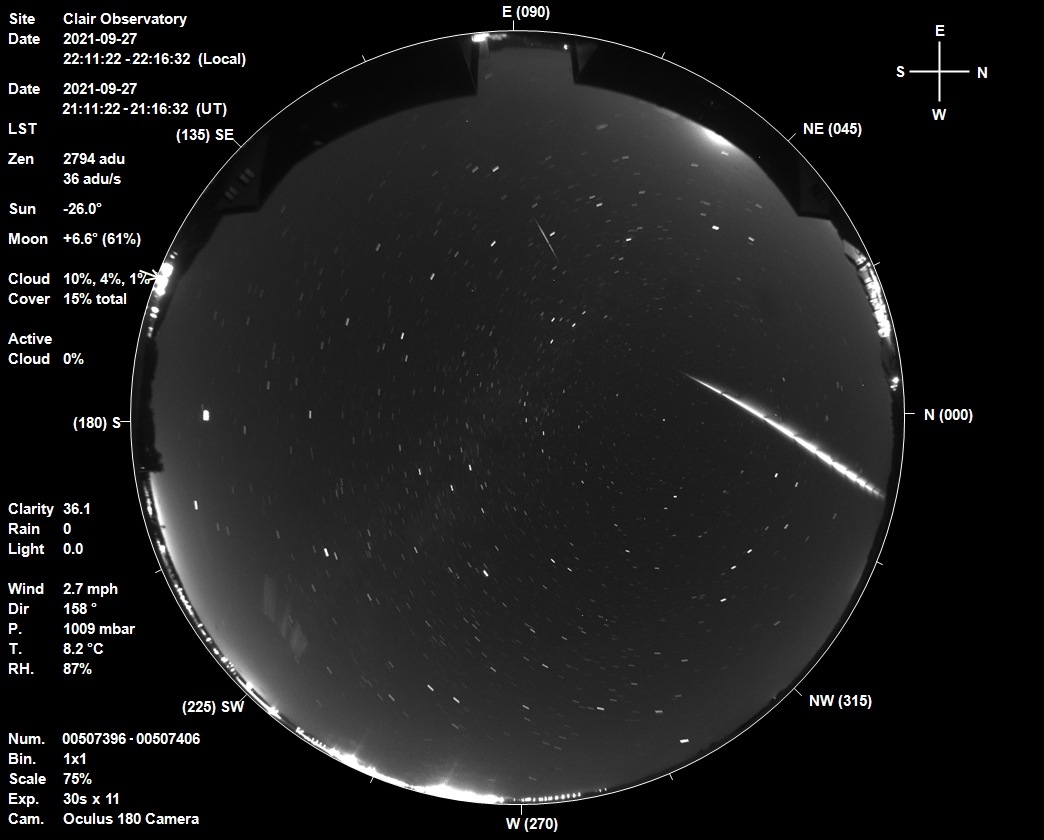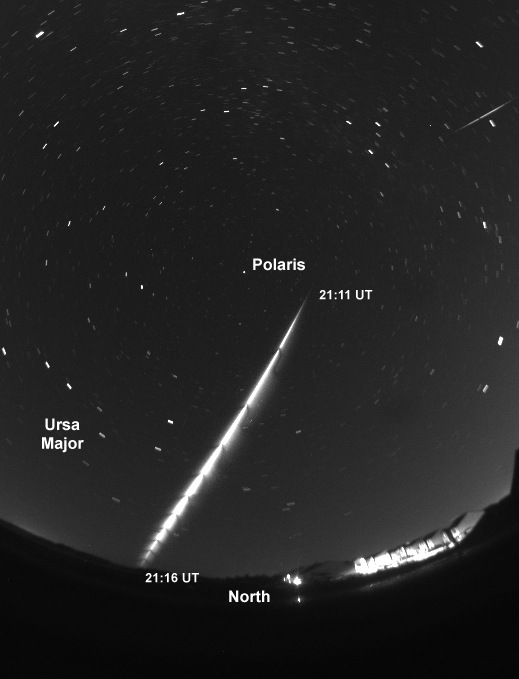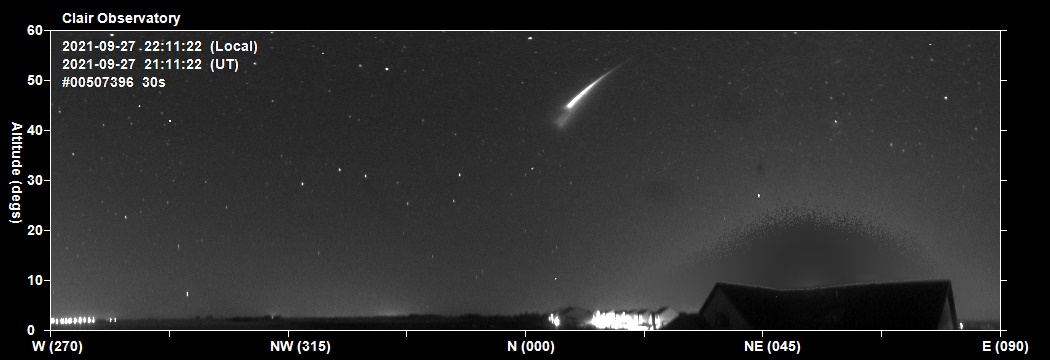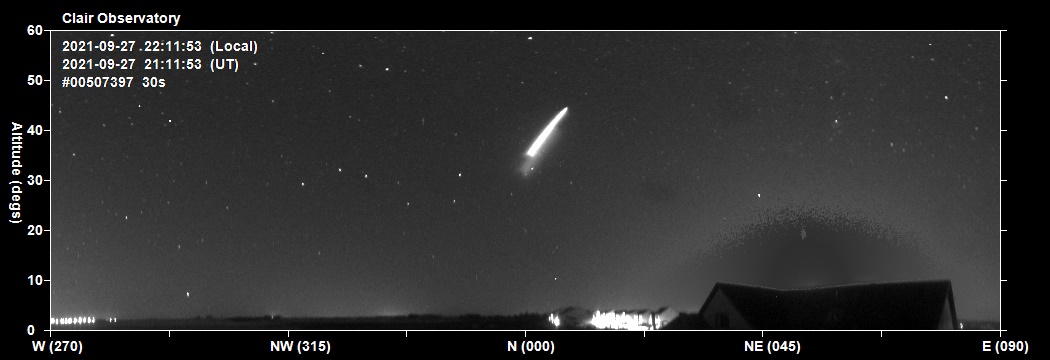David's Astronomy Pages (All Sky Camera)
Atlas V Rocket Burn, 2021-09-27
Aurora
2021-08-27
Aurora
Page
Home
Page
Aurora
2021-10-30
David's Astronomy Pages (All Sky Camera)
|
Aurora 2021-08-27 |
Aurora Page |
Home Page |
Aurora 2021-10-30 |
Data Notes Flight Profile
Pictures Videos
- Rocket burn on Atlas V centaur upper stage. - Burn appeared to start at around 21:11:22 to 21:11:30 UT
- Rocket / exhaust was visible from 21:11 until 21:16 UT when the rocket passed below the NNW horizon.
- Rocket visible in 11 x 30s frames and formed a path starting at Az 17.2°, Alt 52.2° and ending at Az 347.9°, Alt 3.2°- The United Launch Alliance (ULA) Atlas V rocket which had blasted off from Vandenberg Space Force Base in California at 18:12 UT, and had carried the Landsat 9 satellite into orbit with separation occuring at c. 19:20, some 80 minutes after launch. The rocket was initiating a deorbital burn some 178 minutes after launch as it passed across the UK.
The mission's flight profile indicates that the burn corresponded to the Centaur Fourth Main Engine Start (MES-4) that was planned to be a 25s burn starting at T+2:58:44. With launch at 18:12 UT, the burn would be expected at 21:11. This corresponds nicely with the time it was recorded in my AllSky Camera pictures.
- The Atlas V was flying in its simplest configuration: the 401. That means the Landsat 9 satellite was tucked into a 13-foot-wide (4 meters) payload fairing, and the rocket relied on a single-engine Centaur upper stage, with no solid rocket boosters, to propel it to space. Joining Landsat 9 for the ride were four tiny cubesats, which were deploy from the launcher after Landsat 9 has been deposited in space. The launch was the 145th flight of an Atlas V to date and the 88th flight of the rocket for NASA.
Atlas V / LandSat 9 Mission Overview:
https://www.ulalaunch.com/docs/default-source/launch-booklets/mobrochure_landsat9_final1.pdf- The Centaur second stage is 10 ft (3 m) in diameter and 41.5 ft (12.6 m) in length. Its propellant tanks are pressure-stabilized and constructed of corrosion-resistant stainless steel. Centaur is a cryogenic vehicle, fueled with liquid hydrogen and liquid oxygen, powered by an RL10C-1 engine producing 22,900 lbs (101.8 kilo-Newtons) of thrust.
- Landsat 9 satellite will replace the aging Landsat 7 and will eventually settle into an orbit that takes it over the planet's poles at an altitude of about 438 miles (705 km). - Seeing a rocket in European skies is a relatively rare occurence, and it was fortunate that its passage corresponded with perfectly clear skies. - The rocket burn was seen across large area of eastern Scotland and eastern England with many people thinking it was a UFO.!
BBC Report: 'Atlas V: Rocket launch creates strange lights in UK sky'
- Telescope Images from 2021-09-27 >>
| AllSky View - Composite Image, 11 x 30s 2021-09-27 21:11:22 to 21:16:32 UT (22:11:22 to 22:16:32 LT) Image produced by taking maximum pixel values from 11 individual frames (using Sigma Beta 10) Each frame is a 30s exposure and there is a 1s gap between frames |
 |
| Panoramic View - Northern Sky |
| View Looking North - Composite Image, 11 x 30s 2021-09-27 21:11:22 to 21:16:32 UT (22:11:22 to 22:16:32 LT) |
 |
| Montage of Frames - 12 x 30s 2021-09-27 21:10:51 to 21:16:32 UT (22:10:51 to 22:16:32 LT) Each frame is a 30s exposure and there is a 1s gap between frames Rocket is moving in a NNW direction and image of rocket/exhaust is consequently trail in each frame |
 |
| Panoramic View - Northern Sky |
| 2021-09-27 21:11 UT Atlas V Rocket Burn. Moon rising in NE |
 |
| 2021-09-27 21:11:53 UT Atlas V Rocket Burn heading NNW . Moon rising in NE |
 |
Back to Top
| Video: North panoramic view, 13 minute period 2021-09-27 21:05 to 21:17 UT , Frames # 507384 - 408 |
| Link to .mp4 video file (0.5 MB) |
|
0.0s
/ 0.0s
|
Back to Top
| This Web Page: | Atlas V Rocket Burn - 2021-09-27 |
| Last Updated : | 2023-03-29 |
| Site Owner : | David Richards |
| Home Page : | David's Astronomy Web Site |